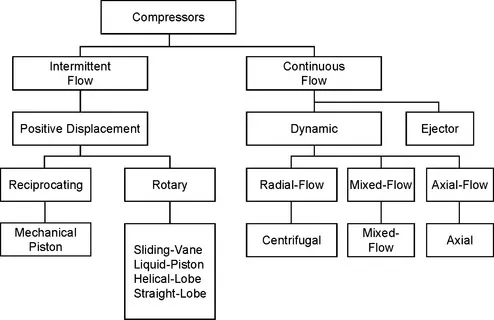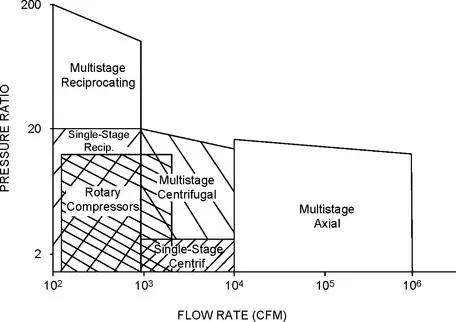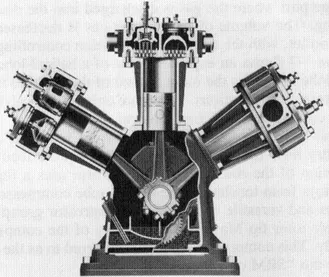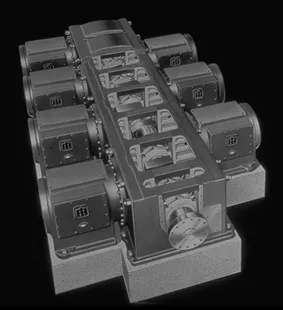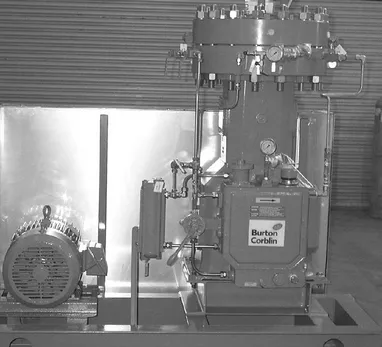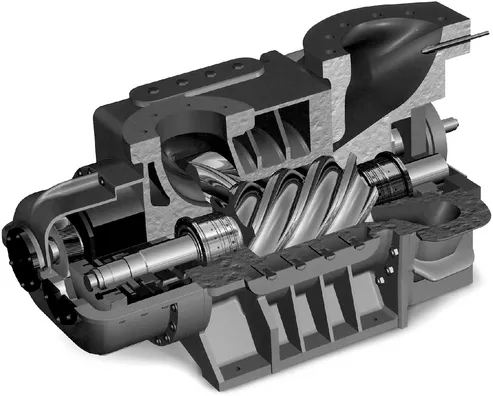Introduction
A compressor is a device used to increase the pressure of a compressible fluid. The inlet pressure level can be any value from a deep vacuum to a high positive pressure. The discharge pressure can range from subatmospheric levels to high values in the tens of thousands of pounds per square inch. The inlet and outlet pressures are related, corresponding with the type of compressor and its configuration. The fluid can be any compressible fluid, either gas or vapor, and can have a wide molecular weight range. Recorded molecular weights of compressed gases range from 2 for hydrogen to 352 for uranium hexafluoride. Applications of compressed gas vary from consumer products, such as home refrigerators, to large complex petrochemical plant installations.
The compressors to be covered in this book are those using mechanical motion to effect the compression. These types of compressors are commonly used in the process and gas transport/distribution industries. A partial list of these industries includes chemical, petrochemical, refinery, pulp and paper, and utilities. A few typical applications are air separation, vapor extraction, refrigeration, steam recompression, and process and plant air.
Compression Methods
Compressors have numerous forms, their exact configurations being based on the application. For comparison, the different types of compressors can be subdivided into two broad groups based on the compression mode, either intermittent or continuous. The intermittent mode of compression is cyclic in nature: A specific quantity of gas is ingested by the compressor, acted upon, and discharged before the cycle is repeated. In the continuous compression mode the gas is moved into the compressor, acted upon, moved through the compressor, and discharged without interruption of the flow at any point in the process.
Compressors using the intermittent compression mode are referred to as positive displacement compressors, of which there are two distinct types: reciprocating and rotary. Continuous-mode compressors are also characterized by two fundamental types: dynamic and ejector.
This chapter will give a brief overview of each of the different compressors commonly used in the process industries. Subsequent chapters will then cover each of the mechanical types in depth. (The ejector type, which does not use mechanical action, will not be covered in detail.) Figure 1-1 diagrams the relationship of the various compressors by type. Figure 1-2 shows the typical application range of each compressor, and Figure 1-3 compares the characteristic curves of the dynamic compressors (axial and centrifugal) with positive displacement compressors.
Intermittent Mode Compressors
Reciprocating Piston Compressors
The reciprocating compressor is probably the best known and the most widely used of all compressors. It consists of a mechanical arrangement in which reciprocating motion is transmitted to a piston that is free to move in a cylinder. The displacing action of the piston, together with the inlet valve or valves, causes a quantity of gas to enter the cylinder where it is in turn compressed and discharged. Action of the discharge valve or valves prevents the backflow of gas from the discharge line into the compressor during the next intake cycle. When the compression takes place on one side of the piston only, the compressor is said to be single-acting. The compressor is double-acting when compression takes place on each side of the piston. Configurations consist of a single cylinder or multiple cylinders on a frame. When a single cylinder is used or when multiple cylinders on a common frame are connected in parallel, the arrangement is referred to as a single-stage compressor. When multiple cylinders on a common frame are connected in series, usually through a cooler, the arrangement is referred to as a multistage compressor. Figures 1-4 and 1-5 illustrate typical reciprocating compressor arrangements, beginning with the single-stage and ending with a more complex multistage.
The reciprocating compressor is generally in the lower flow end of the compressor spectrum. Inlet flows range from less than 100 to approximately 10,000 cfm per cylinder. It is particularly well suited for high pressure service. One of the highest pressure applications is at a discharge pressure of 40,000 psi. Above an approximately 1.5-to-1 pressure ratio, the reciprocating compressor is one of the most efficient of all the compressor types.
Reciprocating Diaphragm Compressors
In the reciprocating compressor family, there is a piece of equipment that is not as well known as the piston type reciprocating compressor. This compressor is the diaphragm compressor—used primarily in lower flow applications—but is capable of high pressure services. It consists of a crankcase assembly very much like the piston compressor, which in fact it is identical to, including a piston. The piston moves oil rather than gas, using the oil to move a diaphragm pack that in turn moves the gas. By the nature of the head construction, the diaphragm does not have any leakage to the atmosphere. Also, there is no leakage toward the inside to contaminate the process gas. Because relatively little power is used, most units are belt-driven by a motor. A single-stage diaphragm compressor is shown in Figure 1-6. The two-stage compressor can be arranged in various configurations similar to the piston compressor, that is, in an L arrangement or an opposed arrangement. Figure 1-7 is an example of an opposed arranged diaphragm compressor.
Rotary Compressors
The rotary compressor portion of the positive displacement family is made up of several compressor configurations. The features these compressors have in common are:
1. They impart energy to the gas being compressed by way of an input shaft moving a single or multiple rotating element.
2. They perform the compression in an intermittent mode.
3. They do not use inlet and discharge valves.
Helical and spiral-lobe compressors are generally similar and use two intermeshing helical or spiral lobes to compress gas between the lobes and the rotor chamber of the casing. The compression cycle begins as the open part of the spiral form of the rotors passes over the inlet port and traps a quantity of gas. The gas is moved axially along the rotor to the discharge port where the gas is discharged into the discharge nozzle of the casing. The volume of the trapped gas is decreased as it moves toward the outlet, with the relative port location controlling the pressure ratio. Figure 1-8 shows a cutaway of an oil-free helical-lobe compressor. The spiral-lobe version is the more limited of the two and is used only in lower pressure applications. Therefore, only the helical-lobe compressor will be covered in depth in this book (see Chapter 4).

